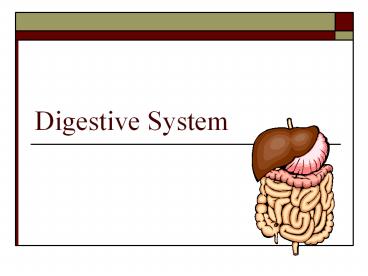Digestive%20System - PowerPoint PPT Presentation
Title: Digestive%20System
1
Digestive System
2
Functions
- 1. Breaks down the food so that the body can use
it - 2. Molecules are absorbed in the blood and
carried throughout the body - 3. Solid wastes are eliminated from the body
3
(No Transcript)
4
An overview of the process
5
- Digestive Process
- Begins
6
4 Processes of Digestion
- Ingestion Getting food into our bodies
- Digestion Breaking down food into smaller
nutrients - Absorption Getting those nutrients into our
bloodstream, so that our cells can use them - Elimination Getting rid of solid waste products
- Eat it!
- Break it Down!
- Soak It Up!
- Go to the Bathroom!
7
2 Types of Digestion
- Digestion means breaking down food into smaller
particles, called nutrients - There are 2 kinds of digestion
- Mechanical Food is broken down by physical
processes (chewing, grinding, moving etc.) - AND
- Chemical Food is broken down by chemicals
(saliva and acids)
8
What are nutrients?
- Nutrients are things that our bodies need to
survive - Water H2O
- Proteins
- Carbohydrates
- Fats
- Vitamins
- Minerals
9
Mouth
- Functions
- Mechanically breaks down food by chewing
- Wets the food with saliva
- Chemically breaks down food with enzymes in saliva
10
Saliva
- Saliva-fluid that is released to help break down
food - chemical digestion- enzymes in saliva mechanical
digestion- soften the bolus for easier swallowing
11
Teeth
- Digestion starts here. The job of the teeth is to
start tearing and crushing the food down into
small enough pieces so that it can fit down our
throats.
12
Epiglottis
- Epiglottis- A flap called the epiglottis closes
over the top of the trachea (windpipe) when
swallowing, so that food does not enter the
respiratory tract - Mucus helps food go down easier
13
Esophagus
Functions Involuntary smooth muscles contract
and push food toward the stomach
14
Peristalsis
- The walls of the digestive tract from the
esophagus to the anus are muscular, and contract
rhythmically to move food. The muscular
contractions are called peristalsis
15
Stomach
- Functions
- The lining releases digestive juice, which
contains - Pepsin- Enzyme that breaks down protein
- Hydrochloric Acid (HCl) - Strong Acid to kill any
bacteria you may have ingested - Thick stomach muscles create a churning motion to
mechanically digest food - What type of internal stimulus causes vomiting?
16
Whats that sound?
- Stomach growling occurs when the stomach
receives signals from your brain to begin
digestion but the stomach is empty. - Your brain might sense you're running low on
energy or even seeing or smelling something you
want to eat can get things going. - The motion of the stomach muscles begins, but
the organ is hollow. - The movement of the muscles mixing the acids of
the stomach in the hollow space of the stomach
produces vibrations we hear as growling, or
rumbling, or gurgling.
See slide note
17
Pancreas
- Attached near the first part of the small
intestine - Produces enzymes that help breaks down starches,
fat and proteins that goes into the small
intestines - Does not break down fiber
18
Liver and Gallbladder
- LIVER
- Breaks down medicines, other substances and helps
break down nitrogen - Produces Bile- breaks up fat particles into small
droplets - Gallbladder-stores the bile
- After you eat the bile passes through a tube from
the gallbladder into the small intestine.
19
Small Intestine
- Functions
- Peristalsis (contraction and relaxation of
muscles) to push the food through - Chemical Digestion through enzymes
- Absorption of nutrients to the blood
20
Blood
- Functions
- Blood Vessels are found within the villi of the
small intestine, here they absorb nutrients and
deliver to the entire body
21
Drying Out and Exiting the Body
- By the time the food that was eaten leaves the
small intestine, most of the usable nutrients
have been digested and absorbed. - The remaining undigested material moves into the
large intestine where large amounts of water are
removed and the final undigested wastes exit the
body through the rectum (stored waste material)
and anus (comes out). - The large intestines also contain large amounts
of bacteria (some sources say over 700 types!)
that digest some of the remaining material and
produce certain vitamins. - These bacteria also produce GAS as a by product!
22
Fun Digestive Facts
- On average, the stomach produces 2 -2.5 liters of
Hydrochloric Acid daily. - After you eat, it takes usually between 24 and 72
hours in healthy adults for the complete process
of digestion to occur. - In the mouth, food is either cooled or warmed to
a more suitable temperature. - Food stays in your stomach for 2 to 3 hours.
- The average male will eat about 50 tons of food
during his lifetime in order to sustain a weight
of 150 pounds.
23
More Fun Digestive Facts
- The liver is the largest and heaviest internal
organ of the body and weighs about 1.6 kilos. - The Liver is the only organ of the body, which
has the capacity to regenerate itself completely
even after being removed almost completely. - Scientists estimate that the average adult
releases between 12 and 122 cubic inches of
intestinal gas each day. Most of that gas is made
up of hydrogen and methane produced by the
bacteria as they ferment the fiber that was not
digested in the stomach or small intestine.































